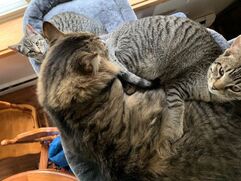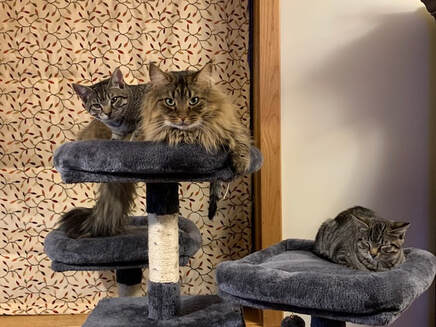New Friends
by Julia Persch
by Julia Persch

Cats are social, affectionate beings, and they generally like the company of other cats.
Unfortunately many domestic cats are raised and kept as single cats and will therefore not easily accept other felines later in life.
But when kittens grow up in a litter, without fear and stress, and spend their early life in company of cats, humans and other species, they will most likely be great companion animals for the rest of their lives.
Valentina’s kittens had the good luck to grow up under ideal circumstances. Our part in this success story has to do with being open to education. Cats are not self-explanatory to humans. We need to learn about their ways of communicating, about what makes them feel safe or terrified, happy or confused. Otherwise we might not be able to read their signs and realize what puts them over the edge to become “A Cat from Hell” as Jackson Galaxy, the cat whisperer, would call them ironically. In most of these cases we humans haven’t understood feline needs.
If we want good cat company, then we have to work for it.
There are skillful ways of introducing cats to a new home and to other pets. The following article gives excellent instructions and has helped many adopters to a happy start with their new feline family members:
https://www.kingdomanimalshelter.com/introducing-a-new-cat-to-your-household.html
If we want good cat company, then we have to work for it.
There are skillful ways of introducing cats to a new home and to other pets. The following article gives excellent instructions and has helped many adopters to a happy start with their new feline family members:
https://www.kingdomanimalshelter.com/introducing-a-new-cat-to-your-household.html

Valentina’s tabby kittens Mack and Noelle benefitted from these instructions when they were adopted by a cat-loving family in Barnet, VT.
On December 2nd, Melissa wrote:
“Here is an update on Henry and Luna, formerly Mack and Noelle. They have fully integrated with the adult male cats in our house. They are still with us at bedtime as they are quite curious at night and tend to be mischievous. We will gradually have them out in the rest of the house later into the evening and eventually overnight, but for now, to ensure they stay safe and don't get into too much trouble they are roaming the house during the day and stay in the bedroom with us overnight.

Since picking them up on November 1st, they have not been home alone. As you can see from the pictures they all like to spend a bit of time on their new cat condo that can accommodate all four of them comfortably. Even though there is enough room for individual space, they are often caught cuddling and cleaning each other (when they aren't napping!).

We were advised to read the article available on the Shelter's website about how to integrate the kittens into a household that already had cats. We all read it and discussed it as a family, so everyone, including my children, knew the guidelines.
I have to say, we followed the recommendations and the transition was flawless! I was very nervous that the introductions and transition into the main living space was going to be stressful for our boys, but it wasn't.
We started by feeding the kittens on one side of the door, and giving our adult boys the wet food can to lick clean, or their own treats on the other side of the door to make it a positive but safe interaction. Once we did this for about a week, we started to prop the door open to let them smell each other and see each other, but they could not touch.
Once this went well, we brought one of our adult boys into their space to smell and wander the room with one kitten at a time. When the adults tolerated the one kitten, we moved to having both kittens and one adult in the room together. As soon as there seemed to be any tension or hesitation by the adult boys, we opened the door and allowed them to leave on their own, but keeping the kittens in their designated room.
On day 14 we were able to let the kittens out into the shared living space and it has been easy sailing ever since.
I have to say, we followed the recommendations and the transition was flawless! I was very nervous that the introductions and transition into the main living space was going to be stressful for our boys, but it wasn't.
We started by feeding the kittens on one side of the door, and giving our adult boys the wet food can to lick clean, or their own treats on the other side of the door to make it a positive but safe interaction. Once we did this for about a week, we started to prop the door open to let them smell each other and see each other, but they could not touch.
Once this went well, we brought one of our adult boys into their space to smell and wander the room with one kitten at a time. When the adults tolerated the one kitten, we moved to having both kittens and one adult in the room together. As soon as there seemed to be any tension or hesitation by the adult boys, we opened the door and allowed them to leave on their own, but keeping the kittens in their designated room.
On day 14 we were able to let the kittens out into the shared living space and it has been easy sailing ever since.

We still have a separate space for the kittens’ food and litter box as recommended. We will likely continue this for some time to ensure they each feel they have their "safe" space to go to if they need a break.”
Thumbs up for this work of love to Melissa and Scott, their children Ella and Jackson, the Maine Coons Charlie and Wicket, and their lucky kittens Henry and Luna!
Thumbs up for this work of love to Melissa and Scott, their children Ella and Jackson, the Maine Coons Charlie and Wicket, and their lucky kittens Henry and Luna!
